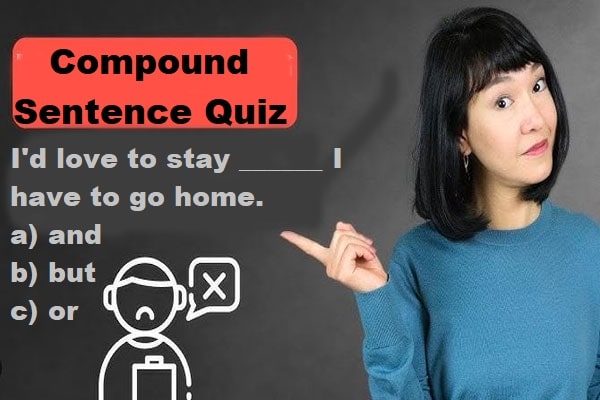Welcome to our Compound Sentence Quiz! This quiz has been created to evaluate your comprehension and familiarity with compound sentences, a crucial element of grammar. Compound sentences are produced by connecting two independent clauses through coordinating conjunctions or semicolons. Throughout this quiz, you will be presented with a range of inquiries that will assess your skill in identifying and composing compound sentences accurately.
A compound sentence is made up of two or more independent clauses connected by conjunctions like “and,” “but,” or “or.” This quiz will test your understanding of how to combine ideas to create clear and concise sentences.
Whether you’re brushing up on grammar or just getting started, this is a fun way to master the art of combining thoughts into one smooth sentence. Ready to challenge yourself?
Compound Sentence Quiz with answers
This quiz aims to enhance your comprehension of compound sentences and their role in achieving clarity.
Participate another quizzes: Past Simple Quiz for Kids and Everyone
Present Perfect Tense Quiz with Answers
Antonym and Synonym Quiz With Answers
Examples and exercises of Compound Sentence test
1. Her hat blew off _______ it fell into a well.
a) but
b) or
c) and
Explain: The right response is “, and”. This connector is employed to show that two actions or events occurred in succession. In this scenario, the hat was first blown off, and subsequently, it dropped into a well.
2. Johnson was scared, _____ she wanted her hat
a) and
b) but
c) or
Explain: The accurate response is “but.” It is a compound sentence comprising two independent clauses linked by the coordinating conjunction “but.” A comma preceding “but” is deemed unnecessary in this scenario due to the presence of solely two brief independent clauses, with the coordinating conjunction.
3. She could accept ___ she could go home.
a) , or
b) , but
c) , and
explain: The accurate response is “, or”. This connecting word is utilized to offer two choices or potential outcomes. In this situation, it indicates that the individual can either agree to something or depart for home.
4. Sofia was rude ____ her father was polite.
a) , but
b) , or
c) , and
Correct: The accurate response is “, yet”. This word is utilized to highlight the difference between Reba Jo’s impoliteness and her father’s courtesy, suggesting that even though Reba Jo acted rudely, her father stayed polite.
5. She kissed the horned toad ____ she didn’t want to.
a) , or
b) , but
c) , and
explain: The accurate response is “, however”. This linking word is utilized to indicate a difference or inconsistency between two concepts. Here, it implies that the act of kissing the horned toad was unforeseen or conflicts with the speaker’s wishes or intentions.
6. The Southwest is hot, dry, and mountainous. This sentence is a ___________ sentence.
a) Compound
b) simple
c) complex
Explain: A basic sentence consists of one independent clause with a subject (“Southwest”) and a verb (“is”), conveying a complete idea. Compound sentences comprise multiple independent clauses, while complex sentences include an independent clause and a dependent clause. Compound-complex sentences contain two or more independent clauses along with at least one dependent clause.
7. She wanted to go to the park, but it started raining. This sentence is a ___________ sentence.
a) simple
b) complex
c) compound
Explain: This is a compound sentence because it contains two independent clauses:
- “She wanted to go to the park“
- “It started raining”
Each clause can stand alone as a complete sentence, but they are joined together by the coordinating conjunction “but.” The conjunction links the two related ideas, showing a contrast between the desire to go to the park and the rain that interferes with that plan.
8. Sometimes it rains hard, but often it is very dry. This sentence is a ___________ sentence.
a) simple
b) compound
c) complex
explain: The sentence “Sometimes there is heavy rainfall, but frequently it is quite dry” comprises two separate clauses connected by the coordinating conjunction “but,” thereby forming a compound sentence.
9. The country is beautiful _______ the people are friendly.
a) and,
b) but,
c) or,
explain: The term “and” is utilized to link two comparable or supportive concepts. In this instance, the statement highlights two favorable aspects of the nation: its attractiveness and the amicability of its inhabitants. Employing “and” appropriately connects these two characteristics.
10. I’d love to stay ______ I have to go home.
a) and
b) but
c) or
explain: The accurate response is “, but”. This connecting word is employed to link two opposing concepts. In this statement, the speaker conveys their wish to remain, but they must depart for home. The inclusion of “but” signifies a clash or inconsistency between the two notions.
11. Which of the following is a compound sentence?
A) She studied for the test because she wanted to do well.
B) I like ice cream, and I enjoy cake.
C) He went to the store after he finished his homework.
Answer: B) I like ice cream, and I enjoy cake.
Explanation: This is a compound sentence because it contains two independent clauses (“I like ice cream” and “I enjoy cake”) joined by the conjunction “and.”
12. Which of these sentences is NOT a compound sentence?
A) She wanted to buy a new book, but she didn’t have enough money.
B) I studied all night, so I passed the exam.
C) He enjoys swimming in the pool.
Explanation: The correct answer is C) He enjoys swimming in the pool. This is a simple sentence, not a compound one, because it only has one independent clause, whereas a compound sentence requires at least two independent clauses joined by a conjunction.
13. What is the role of the word “but” in the following sentence: “I wanted to go for a walk, but it started raining”?
A) It separates two adjectives.
B) It connects two independent clauses.
C) It begins a dependent clause.
Explanation: the correct answer is: B) It connects two independent clauses. “But” is a coordinating conjunction that connects the two independent clauses (“I wanted to go for a walk” and “it started raining”), making the sentence compound.
14. Which sentence is compound?
A) The teacher explained the lesson clearly.
B) She cooked dinner, and he set the table.
C) After the meeting ended, they went for lunch.
Explanation: The Correct answer is: B) She cooked dinner, and he set the table. This is a compound sentence because it has two independent clauses (“She cooked dinner” and “he set the table”) connected by the conjunction “and.”
15. Which of the following correctly combines these two sentences into a compound sentence?
- The sky was clear.
- The sun was setting.
A) The sky was clear while the sun was setting.
B) The sky was clear, for the sun was setting.
C) The sky was clear, and the sun was setting.
Explanation: The correct answer is C) The sky was clear, and the sun was setting. This is the correct compound sentence because it connects the two independent clauses with the conjunction “and,” showing that both actions happened simultaneously.
Frequently Asked Questions on Compound Sentences
What is a compound sentence?
A compound sentence is made up of two or more independent clauses (complete thoughts) connected by a coordinating conjunction (like “and,” “but,” “or,” “nor,” “for,” “so,” “yet”) or a semicolon. Each independent clause could stand alone as a separate sentence.
How do I know if a sentence is compound?
Look for two independent clauses joined by a coordinating conjunction or a semicolon. If both parts could be individual sentences but are connected to express a related idea, it’s a compound sentence.
Can a compound sentence have more than two clauses?
Yes! A compound sentence can have multiple independent clauses joined by conjunctions. For example: “I went to the store, and I bought some bread, but I forgot the milk.”
What’s the difference between a compound sentence and a complex sentence?
A compound sentence has two or more independent clauses, while a complex sentence has one independent clause and at least one dependent clause (which cannot stand alone as a complete sentence). For example, “I went to the store because I needed milk” is complex.
Can I use a semicolon in a compound sentence?
Yes! A semicolon can be used to join two closely related independent clauses without a conjunction. For example: “I finished my homework; now I can relax.”

